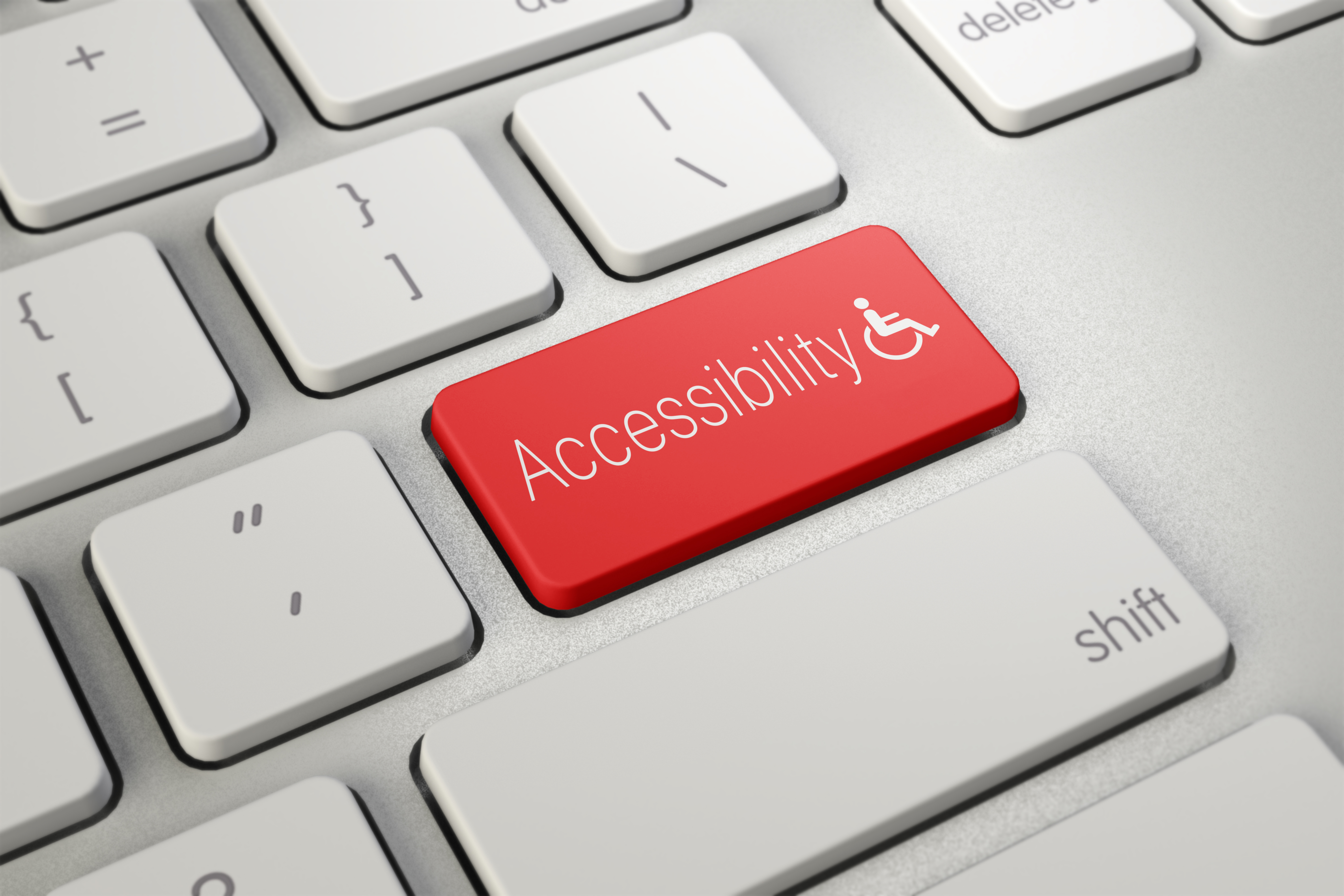Does your public-facing website need to be ADA compliant? The short answer is yes, and it’s more important now than ever. Making (and keeping) your site accessible protects your company and gives all users an equal opportunity to benefit from your resources. Noncompliance with the ADA can have major legal ramifications—and providing a better, more equitable user experience increases customer satisfaction—so it’s important to learn where your site falls short and prioritize fixing the issues.
What Is ADA Compliance?
The ADA is the Americans with Disabilities Act. Originally passed in 1990, this civil rights law encompasses a broad range of protections against discrimination on the basis of disability. You’re probably most familiar with certain provisions like employers’ obligation to provide reasonable accommodations for employees and building regulations that require wheelchair-accessible entrances and exits.
But the act also extends to the internet. An accessible website is one that any user can navigate, regardless of disability. Your users might have differing visual, hearing, or motor abilities, so it’s important to create a site that’s accessible for people using screen readers, voice navigation, and other assistive technologies.
Does My Site Need To Be ADA Compliant?
Under ADA regulations, websites for government and businesses open to the public must maintain certain accessibility standards. If you have a public-facing site, it’s safe to assume that your website needs to be ADA compliant.
The tricky part is that the ADA does not have an official set of regulations for websites. Instead, it simply states that its accessibility rules apply to websites as well as physical locations. This can make it hard to know what you need to do to keep your site compliant.
A good place to start is with the Web Content Accessibility Guidelines (WCAG). Though not officially part of the ADA, following WCAG is mandatory under other laws and covers many of the basic accommodations that might be brought up under an ADA lawsuit.
Still, in many cases, staying up to date on your ADA compliance can be a full-time job. Some companies opt to use a professional service to stay on top of their site and keep up with the latest necessities in accessible web design.
Make Your Website ADA Compliant In 10 Steps
Not sure how to get started with fixing up your site’s accessibility? There are some common first steps everyone should take to ensure they’re providing fair access for all users. We’ll walk through these in more detail, but at a glance, your top priority areas according to the WCAG are to make your website:
- Perceivable: Make accommodations for people with impaired vision.
- Operable: Make it easy to navigate your website with any major tool (not just a mouse).
- Understandable: Make content easy to understand and provide touchpoints to request assistance.
- Robust: Make sure your website cooperates with assistive technologies and can be accessed from various platforms and devices.
1. Check Your Web Accessibility
Before you dive into making any changes, it’s good to get some baseline data about your site. Checking your web accessibility is quick and easy. If you want to tackle everything yourself, there are a number of online tools you can start with right now. Many professional accessibility solutions providers even have free website accessibility tools to help you assess where your website stands.
It’s worth noting that, unless you’re already actively working to comply with ADA or WCAG standards, you’ll probably find some accessibility issues on your site. In other words, a diagnostic test will probably show that your site has problems. That’s ok—most do. The good thing about running an accessibility scan is that you’ll get a better idea of the scope of work involved and figure out how to create an action plan.
2. Understand The Law
While it’s true that the ADA does not have specific language for websites, you can read about their expectations for web design on their official website. Make sure you take time to explore government sites like ADA.org to see official messaging around website compliance. It’s important to understand the reasoning and motivations for ADA compliance directly from the source.
3. Make Your Site Screen Reader Compatible
Screen readers take on-screen text and narrate or output a braille transcription that allows users to engage with your content in alternative ways. This is crucial for many different users with a variety of differences. Visual impairments are typically the first thing we think of when it comes to screen readers, but these assistive technologies are also extremely helpful for some people with reading and learning difficulties.
There’s a lot you can do to make your site more accessible to screen readers, and many of these are also best practices for providing a delightful user experience:
- Make anchor text specific
- If you present a CTA box that says “Click Here,” a screen reader will simply state that, without providing any other context about what the button does. If you make it more specific—think something like “Request A Demo”—the user will know exactly where that link will take them.
- Streamline page content
- Don’t clutter the page with more than you have to. Try to keep things as simple as possible so that people using screen readers can navigate your site efficiently.
- Use proper HTML
- Screen readers need to look at code to understand what they’re reading. This means that headers should be coded H1, H2, and so on, and number lists and tables should be made using designated functions. If you manually create a list or table, you’re likely relying on the visualization—this may not be clear to a screen reader.
4. Use High-Contrast Designs
Low-contrast text and backgrounds can be difficult for any user to read, but they’re especially problematic for users with color-blindness and other visual impairments. If your buttons and banners are already designed according to brand guidelines, you might need to make some changes to make them visible to all users.
Luckily, you can quantify color contrast. The WCAG has minimum contrast specifications, though, in general, more contrast is better. For small text, aim for a contrast higher than 4:5:1. For larger text, aim above 3:1. Thankfully, there is an excellent and free color contrast tool to help your team create inclusive experiences.
5. Provide Additional Cues Beyond Color
For people that may be blind or low vision—make sure you aren’t using color as a sole indicator of meaning. For example, you might want to list benefits and drawbacks of a product. Make sure these are clearly labeled, not simply contrasted with green or red font. This can crop up in many different design situations beyond test—think buttons and CTAs—so it’s critical to develop pages with color blind and low vision users in mind.
6. Use Descriptive Alt Text On Images
Alt text is huge for both accessibility and SEO, so you might already understand why it’s important. On the SEO side, alt text can help search engines understand what’s in an image and how it relates to the rest of your content. This is critical for image search, but also important for traditional search.
Alt text works the same way on the accessibility side. Screen readers narrate alt text, so the only way these users can access your visual content is through your alt text descriptions. Keep these concise, but descriptive, and try to think about what you intend people to take away from your pictures.
7. Always Provide Captions On Videos
A lot of the accommodations discussed so far have been visual, but there are some critical audio accessibility considerations, too. Videos are generally where this comes up the most, and as we begin using video as a medium more and more, it’s increasingly important to make sure we’re creating content that every user can appreciate.
Using captions is an easy way to ensure that users don’t need to hear your videos to understand your content. This is great for users with hearing impairments, but it can also benefit users with sensory processing difficulties who might want to avoid audio input.
8. Enable Your Site For Keyboard Navigation
Not everyone has the ability to navigate the web using a mouse, trackpad, or touch screen (though it’s important that you optimize your site for those, too.) Some users will need to navigate your site with just a keyboard, so make sure you consider this when adding new elements to web pages.
HTML features typically work with keyboard navigation already, but if you want to use something more customizable like CSS, you might need to do a little extra work to make the page accessible.
In general, users will be navigating your site using a few core keys: Tab, Shift, Enter/Return, Escape, and the spacebar and arrow keys. Make sure users are able to interact with elements on the page using Tab. There are also special considerations for using page elements like dropdown menus, widgets, and plugins, as some of these might take extra steps to make them keyboard-friendly.
9. Ensure Compliance With A Third-Party Solution
Keeping up with the latest guidelines in ADA compliance is complicated, and certain implementation steps may be beyond the scope of your team’s usual work. If you test your site and realize it’s not accessible—and you don’t have the time or resources to remedy the issues on your own—there are third-party solutions that can help. These include agencies that diagnose accessibility issues and recommend solutions, but you might also want to consider partnering with another partner who can help you implement those changes.
If you’re interested in working with a partner, TPGi can help audit your site, develop an accessibility roadmap for your team, and recommend a developer to implement fixes.
10. Keep Up With Your Web Compliance
Accessibility is not a one-and-done project. Like SEO, accessibility is an iterative process that takes constant maintenance and ongoing effort to be successful. Even if you’ve gone over your whole site with a fine tooth comb and made sure you’re compliant, you’ll still need to be vigilant when you create new content or update an old page on your site. If not, you might introduce new accessibility issues. Monitoring tools like ARC Monitoring make this a bit easier and can help ensure you don’t fall behind.
FAQs On Website ADA Compliance
Is ADA website compliance mandatory?
The Americans with Disabilities Act does not include language or regulations specifically referencing website guidelines, but public-facing business websites must be accessible. Companies that fail to comply can face heavy lawsuits.
Are sites built on popular web hosting services automatically compliant?
Using a web hosting service like Weebly, WordPress, Wix, and GoDaddy to create your site does not automatically mean you are ADA compliant. Many of these tools may make achieving compliance easier, but if you’ve created your site without paying special attention to accessibility, there’s a good chance there are some issues you need to address.
What laws discuss ADA website compliance?
The Americans with Disabilities Act is the major U.S. law governing accessibility. Unfortunately, the law does not provide comprehensive guidelines for maintaining a compliant website. The official government site does provide resources to assist with compliance, but many website owners use the Web Content Accessibility Guidelines (WCAG) to prevent common accessibility issues.
How do I test my site’s ADA compliance?
There are many free online sources you can use to check your compliance. Many professional services offer free tools to help you get started. See TPGi’s website accessibility tools to get started.
What is the penalty for failing to meet ADA standards?
Lawsuits are becoming an increasingly common penalty for businesses who fail to comply with ADA standards. Under the ADA, these are known as Title III suits, and some law firms now specialize in pursuing these cases. If you are called out for accessibility issues, you can face hefty fines and the potential to land in court.
Keep Your Website Accessible For All
It’s critical to make your site ADA compliant for the sake of your company’s financial and legal health—and for the sake of your many users who rely on accessible designs to navigate the web. Compliance can be complicated, so if you aren’t sure you can independently diagnose and solve your site’s problems, turning to a partner might make sense. The consequences of an ADA lawsuit can be quite steep, and an accessible site opens your business to more customers and clients. Check out TPGi’s accessibility solutions for professional support as you get started.



